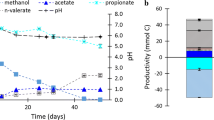Abstract
The L-tert-leucine synthesis was performed continuously in series of two enzyme-membrane reactors by reductive amination of trimethylpyruvate with leucine dehydrogenase. The necessary “native” cofactor NADH is regenerated with the aid of a second enzyme, formate dehydrogenase.
Considering detailed kinetic studies of initial reaction rates under conditions relevant to the process a kinetic model was developed. The model shows that the overall reaction rate is strongly inhibited by the reaction product. The reactor's models combine the mass balances and proposed kinetic equations. The model adequacy was verified by using it to simulate the experiments and by comparing experimental and computed conversion, space-time yield and enzyme consumption.
The calculations for the three reactor's types (batch, single CSTR and a cascade of two CSTRs in series) were compared. The results showed that a single CSTR is no favourable reactor configuration due to the very strong product inhibition. Space-time yield drops from 560 g litre−1 day−1 in a batch reactor to 110 g litre−1 day−1 in a single CSTR at the highest conversion of 98%. At the conversion of 95% the difference in biocatalyst costs between batch and two CSTR in series is negligible. Therefore the use of two enzyme membrane reactors in series was proposed.
The modelling in this work shows that the optimisation of the quantity of the enzyme used results in a minimisation of the biocatalyst costs.
Similar content being viewed by others
Abbreviations
- A :
-
volumetric enzyme activity U ml−1
- C :
-
concentration mmol litre−1
- E :
-
enzyme concentration mg ml−1
- k des :
-
enzyme deactivation constant d−1
- K m :
-
Michaelis-Menten constant mmol litre−1
- K i :
-
inhibition constant mmol litre−1
- M p :
-
molecular weight of product g mol−1
- STY:
-
space-time yield g litre−1 d−1
- t :
-
time min, h or d
- T :
-
temperature °C
- τ :
-
residence time min, h or d
- v i :
-
reaction rate U mg−1
- V m :
-
maximum reaction rate U mg−1
- V R :
-
reactor volume ml
- o :
-
feed
- CSTR:
-
Continuous Stirred Tank Reactor
- EMR:
-
Enzyme Membrane Reactor
- FOR:
-
Formate
- FDH:
-
Formate Dehydrogenase
- LeuDH:
-
Leucine Dehydrogenase
- NADH:
-
cofactor-NicotineAmideadenineDinucleotide
- NH +4 :
-
ammonia
- TLEU:
-
L-tert-Leucine
- TMP:
-
Trimethylpyruvate
References
Kragl, U.;Vasic-Racki, Dj.;Wandrey, C.: Continuous processes with soluble enzymes. Chem. Ing. Tech. 64 (1992) 499–509. Indian J. Chem. Sect. B 32 (1993) 103–117
Bommarius, A.S.;Drauz, K.;Groeger, U.;Wandrey, C.: Membrane bioreactors for the production of enantiomerically pureα-amino acids. In: Collins, A.N.; Sheldrake, C.N.; and Crosby, J. (Eds): Chirality in industry, pp. 372–395. London: J. Wiley 1992
Wandrey, C.;Bossow, B.: Continuous cofactor regeneration — utilisation of polymer bound NAD (H) for the production of optically active acids. Biotechnol. Bioind. 3 (1986) 8–13
Ohshima, T.;Soda, K.: Thermostable amino acid dehydrogenases: applications and gene cloning. Trends Biotechnol. 7 (1989) 210–214
Bommarius, A.S.;Schwarm, M.;Stingl, K.;Kottenhahn, M.;Huthmacher, K.;Drauz, K. Synhesis and use of enantiomerically puretert-leucine. Tetrahedron: Asymmetry 6 (1995) 2851–2888
Weuster-Botz, D.;Paschold, H.;Striegel, B.;Gieren, H.;Kula, M.-R.;Wandrey, C.: Continuous computer controlled production of formate dehydrogenase and isolation on a pilot scale. Chem. Eng. Technol. 17 (1994) 131–137
Kragl, U.;Gödde, A.;Wandrey, C.;Kinzy, W.;Cappon, J.J.;Lugtenburg, J.: Repetitive batch as an efficient method for preparative scale enzymatic synthesis of 5-azido-neuraminic acid and15N-L-glutamic acid. Tetrahedron: Asymmetry 4 (1993) 1193–1202
Kragl, U.; Kruse, W.; Hummel, W.; Wandrey, C.: Enzyme engineering aspects of biocatalysis: cofactor regeneration as example. Biotechnol. Bioeng. (Accepted for publication)
Deuflhard, P.: A modified Newton method for the solution of ill-conditioned systems of nonlinear equations with application to multiple shooting. Numer. Math. 22 (1974) 289
Author information
Authors and Affiliations
Additional information
The authors wish to thank Claudia Burichter and Ursula Mackfeld for their skilful technical assistance. The authors gratefully acknowledge the financial support from the Bundesministerium für Bildung, Wissenschaft, Forschung und Technologie (BMBF) for a scholarship of Mr. C. Plavljanic, Faculty of Chemical Engineering, University of Zagreb, Zagreb, Croatia, who supplied the software NLO used for the mathematical calculations. We thank Prof. Dr. K. Drauz and Dr. A. Bommarius, Degussa AG, Hanau, Germany for stimulating discussions and for providing samples of trimethylpyruvate.
Rights and permissions
About this article
Cite this article
Kragl, U., Vasic-Racki, D. & Wandrey, C. Continuous production of L-tert-leucine in series of two enzyme membrane reactors. Bioprocess Engineering 14, 291–297 (1996). https://doi.org/10.1007/BF00369472
Received:
Issue Date:
DOI: https://doi.org/10.1007/BF00369472




